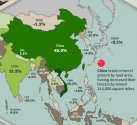You are using an out of date browser. It may not display this or other websites correctly.
You should upgrade or use an alternative browser.
You should upgrade or use an alternative browser.
Climate Change and Renewable Energy News and Discussion
- Thread starter FairAndUnbiased
- Start date
This is interesting and quite impressive I must say. Not really sure what's the efficiency on this thing.
Total domination
China’s solar cell production capacity may reach 600 GW by year-end
The Asia Europe Clean Energy (Solar) Advisory revealed that most of the planned new solar cell production capacity relates to high-efficiency n-type cell technologies such as TOPCon and HJT.
China's total annual solar cell and module production capacity may increase from 361 GW at the end of last year to up to 600 GW at the end of 2022, according to the Asia Europe Clean Energy (Solar) Advisory (AECEA).
So far this year, the output of polysilicon, wafers, cells and modules has already beaten the achievements of the Chinese PV industry in 2021 by some 50%. “By June, module shipments of the TOP 10 manufacturer crossed the 100 GW and by the end of September may have reached 140-150 GW (2021: 133 GW),” said the AECEA. “Just five of these top 10 have set shipment targets of between 183-205 GW.”
Furthermore, the AECEA revealed that the country's polysilicon capacity should grow from around 530,000 MT at the end of 2021 to up to 1.2 million MT in 2022, jumping to 2.5 million MT in 2023, and up to 4 million MT in 2024.
For reference:
2.5 Million tonnes of polysilicon is roughly 1000GW of solar panels, as per Bloomberg.
So 4 Million tonnes of polysilicon is roughly 1600GW of solar panels, which should be able to produce at least 1600 TWh of electricity on a global scale.
Global electricity consumption is only 24000 TWh, and maybe half can be covered by solar. So at this rate, my guess is that by 2035, the solar portion of a completely clean global electricity grid will be built out.
43.3 GW Offshore !!!!China is building the world’s largest wind farm and it could power 13m homes
The next largest offshore project Im aware of is 8.2 GW in South Korea.
broadsword
Brigadier
43.3 GW Offshore !!!!
The next largest offshore project Im aware of is 8.2 GW in South Korea
No, it's also in China as quoted from the report
The title is currently held by the Jiuquan Wind Power base in China, a massive site with a 20 gigawatt capacity.
No, it's also in China as quoted from the report
That is the Gansu one, which is onshore wind
Climate change is a bitch, and so are self imposed sanctions.
Europe is likely to experience a colder, drier and less windy early winter, according to meteorologists, as the UK energy regulator warned there is a “significant risk” of gas shortages this winter.
The European Centre for Medium-Range Weather Forecasts (ECMWF), an independent intergovernmental agency, cautions that predicting winter conditions is “notoriously difficult” in early October. But it says a cold, still and dry snap in November and December, which would worsen the cost of living crisis, is more likely, because of this year’s La Niña – a powerful weather pattern influenced by cooler temperatures in the Pacific.
Carlo Buontempo, the director of the Copernicus Climate Change Service, which is run by the ECMWF on behalf of the EU, said: “La Niña tends to cause disruption to westerly winds, creating high pressure over Europe, which is what the models are showing for the beginning of winter.
The chances of the UK facing a colder winter than normal are increasing, risking higher demand for heating as the energy crisis tightens supplies.
According to Met Office forecasts, the of a cold winter are now slightly higher than usual. “The likelihood of a colder three-month period overall is slightly greater than normal,” the Met said in its outlook.

